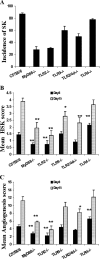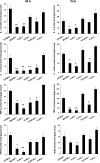Innate recognition network driving herpes simplex virus-induced corneal immunopathology: role of the toll pathway in early inflammatory events in stromal keratitis
- PMID: 17686871
- PMCID: PMC2045562
- DOI: 10.1128/JVI.01008-07
Innate recognition network driving herpes simplex virus-induced corneal immunopathology: role of the toll pathway in early inflammatory events in stromal keratitis
Abstract
Ocular infection with herpes simplex virus (HSV) sets off an array of events that succeed in clearing virus from the cornea but leaves the tissue with a CD4(+) T-cell-orchestrated chronic inflammatory lesion that impairs vision. We demonstrate that Toll-like receptor (TLR) signaling forms a part of the recognition system that induces the syndrome that eventually culminates in immunopathology. Accordingly, in a comparison of the outcomes of infection in wild-type (WT) mice and those lacking TLR function, it was apparent that the absence of TLR2 and, to a lesser extent, TLR9 resulted in significantly diminished lesions. Similarly, mice lacking the adapter molecule MyD88 were resistant to lesion development, but such animals were also unable to control infection, with most succumbing to lethal encephalitis. The susceptibility of TLR4(-/-) animals was also evaluated. These animals developed lesions, which were more severe, more rapidly than did WT animals. We discuss the possible mechanisms by which early recognition of HSV constituents impacts the subsequent development of immunopathological lesions.
Figures







Similar articles
-
Activation of toll-like receptor (TLR)2, TLR4, and TLR9 in the mammalian cornea induces MyD88-dependent corneal inflammation.Invest Ophthalmol Vis Sci. 2005 Feb;46(2):589-95. doi: 10.1167/iovs.04-1077. Invest Ophthalmol Vis Sci. 2005. PMID: 15671286
-
Role of MyD88 in adenovirus keratitis.Immunol Cell Biol. 2017 Jan;95(1):108-116. doi: 10.1038/icb.2016.73. Epub 2016 Aug 16. Immunol Cell Biol. 2017. PMID: 27528076 Free PMC article.
-
Staphylococcus aureus-induced corneal inflammation is dependent on Toll-like receptor 2 and myeloid differentiation factor 88.Infect Immun. 2006 Sep;74(9):5325-32. doi: 10.1128/IAI.00645-06. Infect Immun. 2006. PMID: 16926427 Free PMC article.
-
Impact of Toll-Like Receptors (TLRs) and TLR Signaling Proteins in Trigeminal Ganglia Impairing Herpes Simplex Virus 1 (HSV-1) Progression to Encephalitis: Insights from Mouse Models.Front Biosci (Landmark Ed). 2024 Mar 14;29(3):102. doi: 10.31083/j.fbl2903102. Front Biosci (Landmark Ed). 2024. PMID: 38538263 Review.
-
Who (what) pays toll for the development of herpetic stromal keratitis (HSK).Semin Ophthalmol. 2008 Jul-Aug;23(4):229-34. doi: 10.1080/08820530802111408. Semin Ophthalmol. 2008. PMID: 18584560 Review.
Cited by
-
Herpes Simplex Virus 1 Infection of Neuronal and Non-Neuronal Cells Elicits Specific Innate Immune Responses and Immune Evasion Mechanisms.Front Immunol. 2021 May 31;12:644664. doi: 10.3389/fimmu.2021.644664. eCollection 2021. Front Immunol. 2021. PMID: 34135889 Free PMC article. Review.
-
Scratching the Surface Takes a Toll: Immune Recognition of Viral Proteins by Surface Toll-like Receptors.Viruses. 2022 Dec 24;15(1):52. doi: 10.3390/v15010052. Viruses. 2022. PMID: 36680092 Free PMC article. Review.
-
Toll-like receptors at the ocular surface.Ocul Surf. 2008 Jul;6(3):108-16. doi: 10.1016/s1542-0124(12)70279-3. Ocul Surf. 2008. PMID: 18781257 Free PMC article. Review.
-
Host responses to wild-type and attenuated herpes simplex virus infection in the absence of Stat1.J Virol. 2009 Mar;83(5):2075-87. doi: 10.1128/JVI.02007-08. Epub 2008 Dec 24. J Virol. 2009. PMID: 19109391 Free PMC article.
-
Pathobiology and treatment of viral keratitis.Exp Eye Res. 2021 Apr;205:108483. doi: 10.1016/j.exer.2021.108483. Epub 2021 Feb 6. Exp Eye Res. 2021. PMID: 33556334 Free PMC article. Review.
References
-
- Aravalli, R. N., S. Hu, T. N. Rowen, J. M. Palmquist, and J. R. Lokensgard. 2005. Cutting edge: TLR2-mediated proinflammatory cytokine and chemokine production by microglial cells in response to herpes simplex virus. J. Immunol. 175:4189-4193. - PubMed
-
- Arslan, A., and H. H. Zingg. 1996. Regulation of COX-2 gene expression in rat uterus in vivo and in vitro. Prostaglandins 52:463-481. - PubMed
-
- Banerjee, K., P. S. Biswas, B. Kim, S. Lee, and B. T. Rouse. 2004. CXCR2−/− mice show enhanced susceptibility to herpetic stromal keratitis: a role for IL-6-induced neovascularization. J. Immunol. 172:1237-1245. - PubMed
-
- Banerjee, K., S. Deshpande, M. Zheng, U. Kumaraguru, S. P. Schoenberger, and B. T. Rouse. 2002. Herpetic stromal keratitis in the absence of viral antigen recognition. Cell. Immunol. 219:108-118. - PubMed
-
- Beg, A. A. 2002. Endogenous ligands of Toll-like receptors: implications for regulating inflammatory and immune responses. Trends Immunol. 23:509-512. - PubMed
Publication types
MeSH terms
Substances
Grants and funding
LinkOut - more resources
Full Text Sources
Other Literature Sources
Molecular Biology Databases
Research Materials

